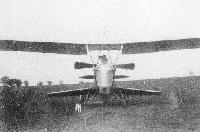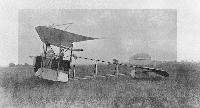P.Lewis British Aircraft 1809-1914 (Putnam)
Megone Biplane
The Megone Biplane was designed and built by W. B. Megone at Hawkinge, Kent, in 1912. The machine was a two-seat pusher with several unorthodox features. The 60 h.p. Green engine was mounted at the front of the nacelle, the 10 ft. diameter propeller being chain-driven through an extension shaft with a Hele-Shaw clutch. The control wires to the tail were taken through the hollow boss of the propeller in the same manner as in the Grahame-White Type 6 and the F.E.3. The passenger was seated behind the pilot, who had a rising seat, and both of them were able to obtain a good downward view by means of celluloid windows provided in the lower wings of the sesquiplane. Wing area, 440 sq. ft.
Показать полностью
M.Goodall, A.Tagg British Aircraft before the Great War (Schiffer)
Deleted by request of (c)Schiffer Publishing
MEGONE biplane (W.B. Megone, Hawkinge, Kent)
The Megone biplane was designed and built by a Dutchman with the assistance of Victor Hunt and others, between 1912 and 1914. The machine appeared in a second version after early unsuccessful trials.
The aircraft was a two-seater pusher biplane, housing the passenger behind the pilot on a lifting seat, giving a good view through celluloid panels in the lower wing for observation purposes. The inverted triangular section tail boom required that the propeller revolve around its top member. The engine was mounted low down in the front of the nacelle with a Hele-Shaw clutch, rear extension shaft and chain drive to the propeller. This arrangement necessitated taking the control cables through the center of the propeller boss, and inside the top tube, to the tail. The tail surfaces consisted of normal tailplane and elevator with a large shield shaped rudder above and a small surface attached to the tail-skid below.
It was reported that various engines were used, including 35 and 60hp Green types, the radiators for cooling being hung on the sides of the nacelle.
The early version of the machine had a short span lower wing with pronounced anhedral apparently without external bracing. The upper wing was braced independently to an inverted vee-shaped pylon above the center section, and by cables to the bottom of the nacelle. After the failure of this version, the lower wing was increased in span and two pairs of interplane struts were introduced; the center pylon was then discarded. The top wing, originally of parallel chord, which embodied the warp, was extended rearwards towards the tips, providing a larger overhanging warping section. The top supports for the warp cables were tilted backwards to match.
The main wheels were mounted on a continuation of the lower longerons, which were curved upwards and originally fitted with small bumper wheels. Small wheels were fitted to the lower wing tips when they were extended.
The machine, in its first version, was ready for testing early in 1913 by Victor Hunt, who acted as test pilot for Megone, but damage resulted. Repairs and experiments continued into 1914, and the machine was still in existence in September of that year. Without warning, Megone suddenly disappeared leaving the machine locked in its shed and creating rumors that he was a spy for Germany.
Power: 60hp Green four-cylinder inline water-cooled. A 35hp Green and other types may also have been tried. A 10ft diameter propeller was fitted.
Data
Wing area 440 sq ft
Tailplane area 54 sq ft
Показать полностью
Журнал Flight
Flight, December 21, 1912.
A NOVEL BIPLANE.
AN interesting biplane has made its appearance at Hawkinge, near Folkestone, where Mr. W. B. Megone has been experimenting for some time past. His present machine is the outcome of several different types of heavier-than-air craft that he has constructed and discarded in reaching the type that he has at present arrived at. It will be seen from the accompanying photograph that while the engine is in front of the passenger, the propeller is driven by means of a shaft behind, and for this reason the machine has considerable interest from the military point of view, for it would be possible to mount an automatic gun in front of the passenger which would have an unhindered range in all directions forward. The machine has not yet been flown, but we understand it is to be put through its tests as soon as its constructor returns from abroad after the holidays. As a biplane its construction is rather different from what is regarded as conventional in this type of craft. Each plane is braced as a monoplane wing, and there are no compression struts between them. The upper plane, it will be noticed, is stiffened by king-post bracing. The machine has an area of 440 sq. ft., not reckoning the tail, which is slightly lifting and which has an area of 54 sq. ft. The tail is supported by a fuselage, triangular in section, over the top member of which revolves the propeller. The two lower members continue forward below the machine to form landing skids. Propulsion is derived from a 60-h.p. Green motor mounted in front of, and on a lower level than, the pilot. It transmits its power through a steel shaft and a Hele-Shaw clutch to the 10-ft. propeller at the rear. The passenger, in this particular machine, sits behind the pilot, and his seat is such that he may raise it at will during flight, so that he may be able, if he needs it, to obtain a better view from the machine. He is able to get a good view of what is passing below him through Cellon windows let into the lower plane on either side. It is a curious feature that the control wires to the tail pass through the propeller boss.
Показать полностью




